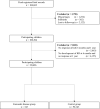Exposures associated with the onset of Kawasaki disease in infancy from the Japan Environment and Children's Study
- PMID: 34172781
- PMCID: PMC8233341
- DOI: 10.1038/s41598-021-92669-z
Exposures associated with the onset of Kawasaki disease in infancy from the Japan Environment and Children's Study
Abstract
Kawasaki disease (KD) is an acute systemic vasculitis that mainly affects infants and young children. The etiology of KD has been discussed for several decades; however, no reproducible risk factors have yet been proven. We used the Japan Environment and Children's Study data to explore the association between the causal effects of exposure during the fetal and neonatal periods and KD onset. The Japan Environment and Children's Study, a nationwide birth cohort study, has followed approximately 100,000 children since 2011. We obtained data on exposures and outcomes from the first trimester to 12 months after birth. Finally, we included 90,486 children who were followed for 12 months. Among them, 343 children developed KD. Multivariate logistic regression revealed that insufficient intake of folic acid during pregnancy (odds ratio [OR], 1.37; 95% CI 1.08-1.74), maternal thyroid disease during pregnancy (OR, 2.03; 95% CI 1.04-3.94), and presence of siblings (OR, 1.33; 95% CI 1.06-1.67) were associated with KD onset in infancy. In this study, we identified three exposures as risk factors for KD. Further well-designed studies are needed to confirm a causal relationship between these exposures and KD onset.
Conflict of interest statement
The authors declare no competing interests.
Similar articles
-
Association between maternal heavy metal exposure and Kawasaki Disease, the Japan Environment and Children's Study (JECS).Sci Rep. 2024 Apr 30;14(1):9947. doi: 10.1038/s41598-024-60830-z. Sci Rep. 2024. PMID: 38689029 Free PMC article.
-
Maternal Serum Folic Acid Levels and Onset of Kawasaki Disease in Offspring During Infancy.JAMA Netw Open. 2023 Dec 1;6(12):e2349942. doi: 10.1001/jamanetworkopen.2023.49942. JAMA Netw Open. 2023. PMID: 38153729 Free PMC article.
-
The association between prenatal per-and polyfluoroalkyl substance levels and Kawasaki disease among children of up to 4 years of age: A prospective birth cohort of the Japan Environment and Children's study.Environ Int. 2024 Jan;183:108321. doi: 10.1016/j.envint.2023.108321. Epub 2023 Nov 11. Environ Int. 2024. PMID: 38061246
-
Kawasaki disease: A brief history.Pediatrics. 2000 Aug;106(2):E27. doi: 10.1542/peds.106.2.e27. Pediatrics. 2000. PMID: 10920183 Review.
-
Kawasaki disease and the environment: an enigmatic interplay.Front Immunol. 2023 Dec 18;14:1259094. doi: 10.3389/fimmu.2023.1259094. eCollection 2023. Front Immunol. 2023. PMID: 38164136 Free PMC article. Review.
Cited by
-
Association between maternal heavy metal exposure and Kawasaki Disease, the Japan Environment and Children's Study (JECS).Sci Rep. 2024 Apr 30;14(1):9947. doi: 10.1038/s41598-024-60830-z. Sci Rep. 2024. PMID: 38689029 Free PMC article.
-
An Unintended Consequence of Pandemic Control Measures: Fewer Cases of Kawasaki Disease.J Pediatr. 2021 Dec;239:11-14. doi: 10.1016/j.jpeds.2021.08.069. Epub 2021 Aug 26. J Pediatr. 2021. PMID: 34454952 Free PMC article. No abstract available.
-
Evaluating the time-varying risk of hypertension, cardiac events, and mortality following Kawasaki disease diagnosis.Pediatr Res. 2023 Apr;93(5):1439-1446. doi: 10.1038/s41390-022-02273-8. Epub 2022 Aug 24. Pediatr Res. 2023. PMID: 36002584
-
Evaluation of the association of birth order and group childcare attendance with Kawasaki disease using data from a nationwide longitudinal survey.Front Pediatr. 2023 Mar 28;11:1127053. doi: 10.3389/fped.2023.1127053. eCollection 2023. Front Pediatr. 2023. PMID: 37056943 Free PMC article.
-
The etiologies of Kawasaki disease.J Clin Invest. 2024 Mar 1;134(5):e176938. doi: 10.1172/JCI176938. J Clin Invest. 2024. PMID: 38426498 Free PMC article. Review.
References
-
- Kawasaki T. Acute febrile mucocutaneous syndrome with lymphoid involvement with specific desquamation of the fingers and toes in children. Arerugi. 1967;16:178–222. - PubMed
-
- McCrindle BW, et al. Diagnosis, treatment, and long-term management of Kawasaki disease: A scientific statement for health professionals from the American Heart Association [published correction appears in Circulation. 140, e181–e184 (2019)] Circulation. 2017;135:e927–e999. doi: 10.1161/CIR.0000000000000484. - DOI - PubMed
Publication types
MeSH terms
LinkOut - more resources
Full Text Sources
Medical


